The night sky has always fascinated humanity, sparking our collective imagination and inspiring countless myths and legends. Among the celestial wonders that captivate stargazers is the enigmatic Ophiuchus constellation. This constellation has a rich and intriguing mythology, with origins that date back to ancient civilizations. In this article, we will delve into the captivating mythology and origins of Ophiuchus, explore its astronomical significance, and discover the celestial wonders it holds. Get ready to embark on a cosmic journey and uncover the secrets of this mysterious constellation.
Contents
- The Ophiuchus Constellation: An Overview
- Mythological Origins of Ophiuchus
- Astronomical Significance of Ophiuchus
- Star Clusters and Celestial Wonders in Ophiuchus
- Exploring Ophiuchus in the Night Sky
- Conclusion
- Frequently Asked Questions
- References
-
Frequently Asked Questions
- 1. How did Ophiuchus get its name?
- 2. What is the significance of the Ophiuchus constellation in astrology?
- 3. Is Ophiuchus considered the 13th zodiac sign?
- 4. Can Ophiuchus be easily identified in the night sky?
- 5. How did Greek mythology describe the Ophiuchus constellation?
- 6. What is the Egyptian interpretation of Ophiuchus?
- 7. Are there any other cultural interpretations of Ophiuchus?
- 8. Are there any notable celestial objects within the Ophiuchus constellation?
- 9. Can Ophiuchus be observed during specific times of the year?
- 10. Does Ophiuchus play a role in modern astronomy?
- References
- Read More
The Ophiuchus Constellation: An Overview
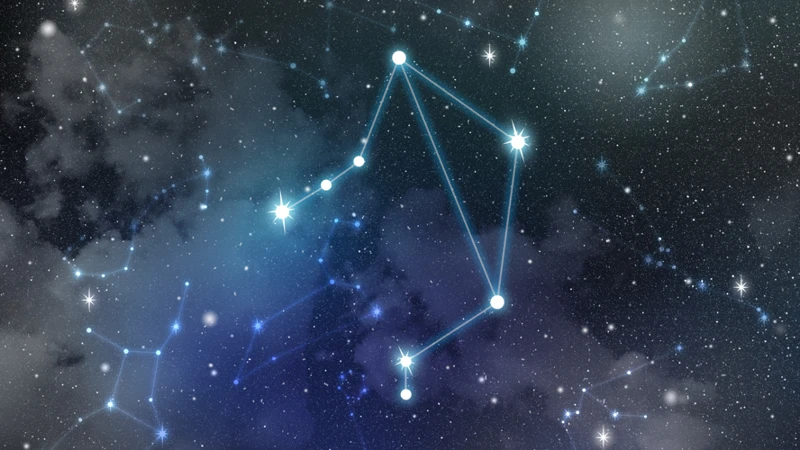
The Ophiuchus constellation, also known as the “Serpent Bearer,” is a prominent constellation that lies in the southern hemisphere. It is characterized by its distinctive shape, resembling a figure holding a serpent. Ophiuchus is positioned between the constellations of Hercules and Scorpius and is bordered by other well-known constellations such as Serpens and Aquila. Ophiuchus holds a significant place in both ancient mythology and modern astronomy. It is associated with various mythological tales that showcase its mythical origins and symbolic representation. Ophiuchus plays a role in astrology, where it is often considered the 13th zodiac sign, causing controversy and debate among astrologers. To gain a better understanding of Ophiuchus and its significance, we will explore its mythological origins, delve into its astronomical significance, and discover the mesmerizing celestial objects within its boundaries. So let’s embark on this cosmic journey and unravel the mysteries of the fascinating Ophiuchus constellation.
1.1 What is Ophiuchus?
Ophiuchus, also known as the “Serpent Bearer,” is a constellation that holds a prominent position in the sky. It is situated near the celestial equator, traversing the southern hemisphere. Ophiuchus is often depicted as a figure holding a serpent, symbolizing the Greek myth of Asclepius, the god of medicine and healing. The constellation is bordered by Hercules and Scorpius, and neighboring constellations include Serpens and Aquila. Ophiuchus is visible during the summer months in the Northern Hemisphere and during the winter months in the Southern Hemisphere. With its unique shape and position, Ophiuchus stands out among the other constellations in the night sky. Its cultural and mythological significance adds to the intrigue and mystique surrounding this celestial formation. So, let’s explore the fascinating mythology and origins of Ophiuchus and uncover its astronomical significance in greater detail.
1.2 Ophiuchus in the Night Sky
Ophiuchus, the serpent bearer, is a captivating constellation that graces the night sky. To locate Ophiuchus, one must first find the bright star Antares in the neighboring constellation Scorpius. From there, trace a line upward and slightly to the left to spot the head of Serpens, a serpent held by Ophiuchus. The constellation is positioned in the southern part of the sky and is best visible during the summer months in the Northern Hemisphere. Ophiuchus occupies a vast area of the celestial sphere, making it one of the larger constellations. Its distinct shape, resembling a person holding a serpent, is striking and easily recognizable. The Ophiuchus constellation serves as a celestial guide, helping astronomers orient themselves in the vastness of space as they explore other modern constellations and deep sky objects. Spend a clear summer night gazing at the stars, and let the mesmerizing presence of Ophiuchus captivate your imagination.
Mythological Origins of Ophiuchus
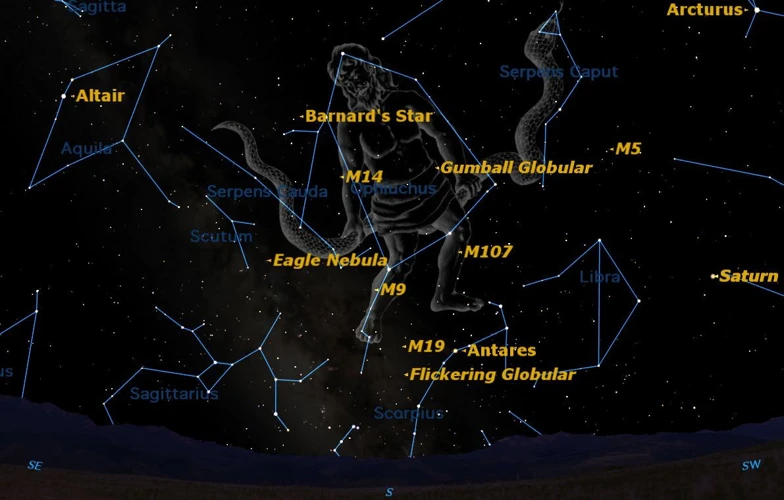
The mythological origins of Ophiuchus are steeped in ancient tales of different cultures. In Greek mythology, Ophiuchus is associated with the legendary figure of Asclepius, the god of medicine and healing. Asclepius was known for his exceptional healing abilities and was often depicted holding a serpent-entwined staff, which is now recognized as the symbol of medicine. The story goes that Asclepius was able to resurrect the dead using his healing powers, which angered the Greek gods. As a result, Zeus struck him down with a lightning bolt, but later immortalized him in the heavens as the constellation Ophiuchus. In Egyptian mythology, Ophiuchus is linked to the god Imhotep, who was revered as the god of medicine and wisdom. Imhotep was a high priest, architect, and physician who was later deified. He was believed to have the power to heal and was often depicted accompanied by a serpent, symbolizing his connection to Ophiuchus. These mythological tales highlight the significance of Ophiuchus as a symbol of healing and wisdom in different cultures.
2.1 Greek Mythology: The Healer and the Serpent
In Greek mythology, the story of Ophiuchus revolves around a renowned healer named Asclepius. According to legend, Asclepius was the son of Apollo, the god of medicine and healing. Asclepius possessed exceptional knowledge and skill in the art of healing, surpassing all other mortal physicians. His abilities were so remarkable that he could even bring the dead back to life. This extraordinary talent, however, drew the attention of Hades, the god of the underworld, who became concerned about the imbalance it could cause between the realms of the living and the dead. Out of fear and jealousy, Hades sought to put an end to Asclepius’ healing prowess. He devised a plan and sent a venomous serpent to kill the skilled healer. Asclepius fought bravely and managed to slay the serpent, but as he did so, another snake appeared with a healing herb in its mouth. Recognizing the significance of this event, Asclepius understood that healing could arise even from the most venomous sources. He used the herb to revive the serpent and strengthen its healing powers. Asclepius eventually became associated with the symbol of a serpent coiled around a staff, known today as the Rod of Asclepius, which is a universal symbol of medicine and healing. This fascinating tale of the healer and the serpent highlights both the power of healing and the interplay between life and death in Greek mythology. It showcases the transformation of a deadly encounter into a symbol of healing and wisdom, leaving a lasting legacy that still resonates in the field of medicine today. So, Ophiuchus not only stands as a celestial figure but also represents the eternal connection between healing and the serpent in Greek mythology.
2.2 Egyptian Mythology: Imhotep and the Serpent of Wisdom
In Egyptian mythology, the story of Imhotep and the Serpent of Wisdom is deeply intertwined with the Ophiuchus constellation. Imhotep, who was a revered figure in ancient Egypt, was believed to possess great knowledge and wisdom. He was known as a skilled physician, architect, and high priest. In the mythology, Imhotep was said to have been bestowed with the power to heal by the gods. It is believed that Imhotep’s healing abilities were so extraordinary that he was able to resurrect the dead. The Serpent of Wisdom, represented by a snake, played a significant role in Imhotep’s mythological narrative. The snake symbolized knowledge, healing, and divine wisdom. It is said that Imhotep received his profound wisdom directly from the Serpent of Wisdom, who would whisper secrets and insights into his ear. The snake, therefore, became a symbol of Imhotep’s close connection with the divine and his ability to channel divine wisdom. This mythological association between Imhotep, the Serpent of Wisdom, and the Ophiuchus constellation showcases the strong influence of Egyptian mythology on the celestial narrative and the importance placed on wisdom and healing in their culture. To delve deeper into the role of Egyptian mythology in understanding Ophiuchus, you can read more about the /role-isis-egyptian-mythology/ and their beliefs.
2.3 Other Cultural Interpretations
Other cultural interpretations of the Ophiuchus constellation provide diverse perspectives on its significance. In Japanese mythology, Ophiuchus is associated with the symbol of a snake, representing medicine and healing. The snake is considered a sacred animal, embodying wisdom and transformation. In Japanese culture, the snake is associated with Orochi, a legendary eight-headed serpent that was defeated by the god Susanoo. This connection between the snake and healing is reflected in the Ophiuchus constellation, where the figure is depicted as a healer holding a serpent. This symbolism of healing and wisdom is also found in other cultures, such as ancient Mayan and Aztec civilizations, where serpents were associated with deities of knowledge and rebirth. Exploring different cultural interpretations of Ophiuchus offers a fascinating insight into the universal themes of healing, transformation, and the pursuit of wisdom across different civilizations. Understanding these diverse perspectives adds depth to our exploration of the Ophiuchus constellation and its mythical origins.
Astronomical Significance of Ophiuchus
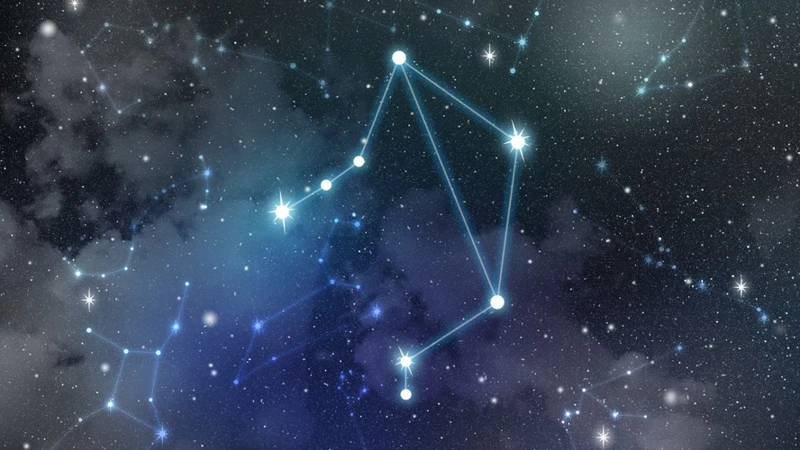
The Ophiuchus constellation holds great astronomical significance and plays a role in both astrology and modern astronomy. In astrology, Ophiuchus is often considered the 13th zodiac sign, representing a unique personality type and influencing celestial alignments. However, the controversy surrounding its inclusion in the zodiac remains a topic of debate among astrologers. In modern astronomy, Ophiuchus is home to various intriguing celestial objects and star clusters. Notably, Ophiuchus houses several Messier objects, such as the famous globular cluster M14 and the stunning M10, which dazzles stargazers with its beauty. Ophiuchus is also associated with the Ophiuchus Molecular Cloud Complex, a region where new stars are formed. Exploring Ophiuchus in the night sky offers a glimpse into the incredible wonders of the universe and highlights the significance of this captivating constellation.
3.1 Ophiuchus and Astrology
When it comes to astrology, Ophiuchus has an intriguing relationship. In traditional astrology, which follows the horoscope system, the zodiac is divided into 12 signs, each representing a specific period of the year. However, Ophiuchus is not included in this system. According to the astrology community, people born between November 29 and December 17 fall under the sign of Ophiuchus. Those born under this sign are believed to possess traits such as healing abilities, wisdom, and a thirst for knowledge. Ophiuchus is often associated with the symbol of a serpent, reflecting the constellation’s connection to healing and medicine. While not officially recognized as a zodiac sign, Ophiuchus has gained a following among astrology enthusiasts who believe in the power and influence of this lesser-known constellation. Its inclusion in astrology has sparked discussions and debates about the legitimacy of Ophiuchus as the 13th zodiac sign. Whether you align with traditional astrology or embrace the idea of Ophiuchus as an additional sign, its presence adds an intriguing layer to the complex world of astrology. If you’re curious to explore more about the symbolism of animals in mythology, you can read our article on Japanese mythology.
3.2 The Zodiac Controversy: Ophiuchus as the 13th Sign
The Zodiac Controversy surrounding Ophiuchus as the 13th sign has been a topic of debate among astrologers and astronomy enthusiasts. Traditionally, the zodiac consists of 12 signs, each representing a specific period of the year. However, some argue that the addition of Ophiuchus should make it the 13th sign, disrupting the established order.
According to astrological theories, Ophiuchus would fall between Scorpio and Sagittarius, challenging the long-accepted dates and characteristics of the existing signs. Those who support the inclusion of Ophiuchus argue that it brings forth a more accurate representation of the zodiac and may provide deeper insights into one’s personality traits. They believe that individuals born under the Ophiuchus sign possess unique qualities such as wisdom, healing abilities, and a natural inclination towards seeking knowledge.
However, critics of adding Ophiuchus as the 13th sign raise valid concerns about the already established system and the potential confusion it may cause. Changing the zodiac system could require recalibrating charts, adjusting horoscopes, and altering centuries of astrological interpretations. Additionally, some argue that the incorporation of Ophiuchus may oversimplify the depth and complexity of astrology and the individuality of each person’s birth chart.
Ultimately, whether Ophiuchus should be recognized as the 13th sign remains a heated topic with no definitive conclusion. As astrology continues to evolve and adapt, it is up to individuals to explore and interpret the influence of Ophiuchus on their lives, should they choose to embrace its presence in the zodiac system.
3.3 Ophiuchus in Modern Astronomy
Ophiuchus continues to captivate astronomers in the realm of modern astronomy, offering fascinating insights into the cosmos. In this section, we will explore the role of Ophiuchus in modern astronomy. One of the key contributions of Ophiuchus in astronomical research is its association with star formation. Within the constellation lies several regions of active star formation, such as the Ophiuchus Molecular Cloud Complex. This complex consists of dark clouds of gas and dust that serve as stellar nurseries, giving birth to new stars. Astronomers study these regions to understand the processes involved in star formation and gain insights into the evolution of stellar systems. Additionally, Ophiuchus is home to numerous variable stars, which are stars that exhibit changes in brightness over time. By monitoring these variations, astronomers can gather valuable data about the physical properties of stars and their underlying mechanisms. Ophiuchus also serves as a stellar reference point for other astronomical research. Its positioning in the sky allows astronomers to study the movements and interactions of celestial objects, such as galaxies and other star clusters. Through ongoing observations and research, Ophiuchus contributes to our understanding of the universe and its dynamic nature. This constellation represents an important area of study in modern astronomy, leaving us in awe of the cosmic wonders it continues to reveal.
Star Clusters and Celestial Wonders in Ophiuchus
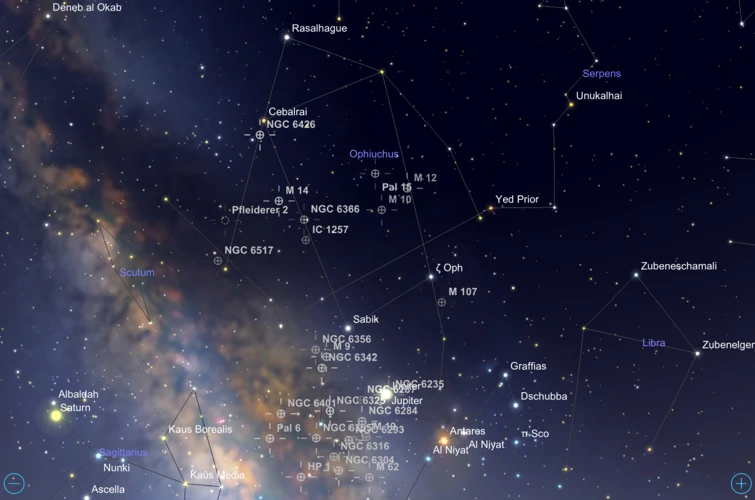
Within the boundaries of the Ophiuchus constellation, stargazers are treated to a dazzling array of celestial wonders. One of the standout features within Ophiuchus is the presence of several remarkable star clusters, captivating astronomers and amateur stargazers alike. One such star cluster is Messier 10, a globular cluster located near the constellation’s head. This cluster is composed of thousands of stars and offers a breathtaking sight through a telescope. Another notable celestial wonder within Ophiuchus is the Dark Horse Nebula. This dark cloud of interstellar dust forms the shape of a horse, adding a touch of whimsy to the cosmic landscape. Additionally, stargazers can marvel at the Barnard’s Star, a red dwarf star located in Ophiuchus that is notable for being the fourth-closest individual star to Earth. With its stunning star clusters, captivating nebulae, and intriguing individual stars, Ophiuchus provides an abundance of celestial wonders for those who turn their gaze to the night sky.
4.1 Messier Objects in Ophiuchus
The Ophiuchus constellation is home to several fascinating celestial objects, including a number of Messier objects that have captured the attention of astronomers and stargazers alike. These Messier objects are part of a renowned catalog created by French astronomer Charles Messier in the 18th century, listing various deep-sky objects. In Ophiuchus, we can find a few notable Messier objects that are worth exploring. One such object is Messier 9, a globular cluster located approximately 25,000 light-years away from Earth. This cluster is composed of hundreds of thousands of stars tightly packed together, forming a dazzling display. Another noteworthy Messier object in Ophiuchus is Messier 19, another globular cluster situated around 28,000 light-years away. Messier 19 is unique in that it has a distorted shape due to its close proximity to the galaxy’s center. Additionally, Ophiuchus is home to Messier 10, yet another globular cluster that resides roughly 14,000 light-years from us. This cluster stands out due to its dense core, where stars are densely concentrated. Exploring these Messier objects within the boundaries of Ophiuchus provides a thrilling opportunity to witness the captivating beauty and complexity of our vast universe.
4.2 Other Notable Celestial Objects
4.2 Other Notable Celestial Objects:
When exploring the vast expanse of the Ophiuchus constellation, one cannot overlook the presence of various other remarkable celestial objects. These objects include beautiful star clusters, nebulae, and other astronomical wonders that add to the allure of Ophiuchus.
The Barnard’s Star: One of the notable stars in Ophiuchus is Barnard’s Star, named after the American astronomer Edward Emerson Barnard. This star is renowned for being the fourth-closest known individual star to the Earth, with a distance of only 5.96 light-years. Despite its proximity, Barnard’s Star is a red dwarf and is relatively dim, making it a challenging object to observe without adequate equipment.
The Pipe Nebula: Within the boundaries of Ophiuchus lies a dark nebula known as the Pipe Nebula. This visually striking nebula takes on the shape of a long, dark “pipe” stretching across the night sky. It is composed of dense interstellar dust that obscures the light from background stars, creating a fascinating visual contrast against the surrounding star fields.
The Barnard 72: Another intriguing celestial object within Ophiuchus is Barnard 72, also known as the Snake Nebula. This dark nebula gets its name from its snake-like appearance, resembling a coiled serpent swirling through space. It is such a captivating sight that it often becomes a favorite target for astrophotographers and amateur stargazers alike.
These are just a few examples of the many celestial wonders found within the Ophiuchus constellation. Exploring these objects with a telescope or even admiring their beauty with the naked eye can truly deepen one’s appreciation for the cosmic treasures that lie in the depths of the night sky.
Exploring Ophiuchus in the Night Sky
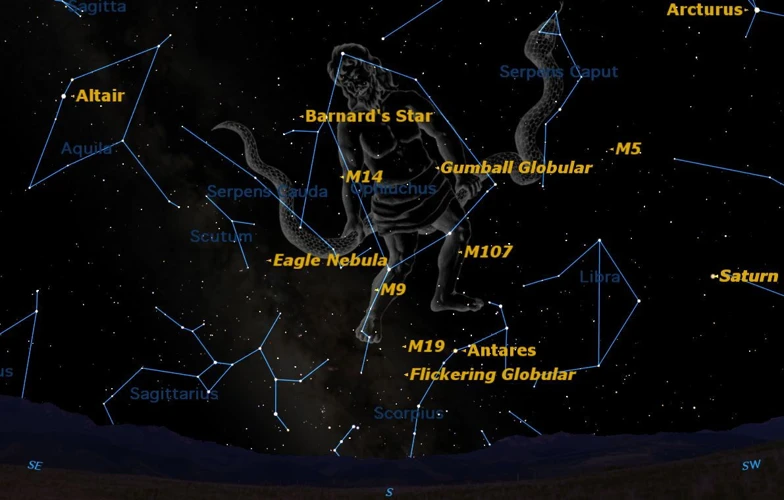
Exploring Ophiuchus in the night sky offers a thrilling experience for stargazers and astronomy enthusiasts alike. This captivating constellation can be located by identifying key stars and features within its boundaries. Ophiuchus lies in the direction away from the center of our Milky Way galaxy, making it a prime location for observing celestial wonders. One notable feature of Ophiuchus is its association with the Zodiac constellations. Although not officially recognized as a part of the Zodiac, Ophiuchus is nestled between Scorpius and Sagittarius, adding intrigue and complexity to the cosmic landscape. By identifying the key stars, such as Rasalhague and Sabik, and using star charts or stargazing apps, observers can easily locate and admire the beauty of Ophiuchus. The best times for observing Ophiuchus are during spring and summer in the northern hemisphere, when it rises higher in the sky and becomes more visible. So, grab your telescope or binoculars, find a clear, dark spot away from light pollution, and immerse yourself in the wonders of Ophiuchus in the night sky.
5.1 Ophiuchus and Zodiac Constellations
Ophiuchus, though not officially recognized as one of the twelve zodiac constellations, has a unique relationship with them. In astrology, the zodiac consists of a set of constellations that are believed to influence the personality traits and characteristics of individuals born under their influence. Traditionally, the zodiac is composed of twelve signs, each associated with a specific time period of the year. However, the inclusion of Ophiuchus as the thirteenth sign has stirred controversy in recent times.
According to some astrologers, Ophiuchus represents a powerful archetype that incorporates traits of both Scorpio and Sagittarius. Those born between November 29 and December 17 are considered to fall under the influence of Ophiuchus. People associated with this sign are believed to possess qualities such as wisdom, healing abilities, and a deep spiritual connection.
While Ophiuchus may not be officially recognized as a zodiac sign, its inclusion in astrology discussions has sparked interest and debate among astrology enthusiasts. The idea of an additional sign adds a new layer of complexity to understanding astrological interpretations and influences on individuals’ lives. Whether one includes Ophiuchus in their zodiac considerations or not, the celestial presence of this unique serpent-bearer constellation continues to fascinate stargazers and astrologers alike.
5.2 Identifying Ophiuchus: Stars and Key Features
Identifying the Ophiuchus constellation amidst the vast expanse of stars is an awe-inspiring task for stargazers. However, with a little knowledge and guidance, you can spot this magnificent constellation in the night sky. One of the key ways to identify Ophiuchus is by looking for its prominent stars and key features. Here are some essential stars and distinguishing characteristics that can help you locate Ophiuchus:
1. Rasalhague (Alpha Ophiuchi): Also known as the “Head of the Serpent Bearer,” Rasalhague is the brightest star in the Ophiuchus constellation. It serves as a reliable anchor point for identifying the constellation.
2. Sabik (Eta Ophiuchi): Located near Rasalhague, Sabik is another bright star within Ophiuchus. Its brightness and proximity to Rasalhague make it easier to spot.
3. Theta Ophiuchi: This star is part of the “Ophiuchus’ knee,” forming an essential component in distinguishing the serpent holder figure within the constellation.
4. Barnard’s Star: Considered one of the closest individual stars to the Solar System, Barnard’s Star is also situated within the boundaries of Ophiuchus.
Apart from the stars, another key feature of Ophiuchus is the Barnard’s Star: Considered one of the closest individual stars to the Solar System, Barnard’s Star is also situated within the boundaries of Ophiuchus.
Key Features of Ophiuchus:
The Serpent: Ophiuchus is often depicted as a figure holding a serpent. The serpent wraps around the figure and is an essential characteristic to look for when identifying the constellation.
The Celestial Equator: Ophiuchus lies along the celestial equator, an imaginary line projected onto the sky that divides the Earth’s celestial sphere into northern and southern hemispheres. This positioning makes it visible from different parts of the world.
To locate Ophiuchus, it is helpful to find neighboring constellations. Hercules and Scorpius are adjacent constellations that can act as useful references for finding Ophiuchus in the night sky.
Remember, identifying constellations requires patience and a dark sky free from light pollution. Using star charts or mobile apps can also aid in accurate identification. So, armed with the knowledge of its prominent stars and key features, embark on your stargazing adventure and marvel at the celestial wonders of the glorious Ophiuchus constellation.
5.3 Best Times for Ophiuchus Observation
To observe the Ophiuchus constellation in all its glory, it is important to know the best times for observation. Ophiuchus is visible in the night sky during specific seasons, depending on your location and the time of year. The optimal viewing period for Ophiuchus is during the summer months in the northern hemisphere, typically from May to August. During these months, Ophiuchus is positioned high in the sky, allowing for better visibility and fewer obstructions. It is recommended to observe Ophiuchus during moonless nights or when the moon is in its early stages, as bright moonlight can make it difficult to spot fainter stars and celestial objects. Finding a location away from light pollution is also crucial for a clearer view of the constellation. Using a star chart or a planetarium app can assist in identifying the precise location and best viewing times for Ophiuchus. So, mark your calendars and plan your stargazing sessions accordingly to catch a glimpse of the mesmerizing Ophiuchus constellation.
Conclusion

In conclusion, the Ophiuchus constellation is a captivating celestial wonder that has captured the imaginations of cultures throughout history. Its intriguing mythology, with Greek and Egyptian origins, offers insights into the symbolism and significance of this enigmatic constellation. While Ophiuchus is not officially recognized as a zodiac sign in astrology, it has sparked controversy and inspired discussions about the nature of the zodiac and its interpretation. From an astronomical standpoint, Ophiuchus holds a wealth of celestial wonders, including star clusters, nebulae, and other notable objects that provide endless opportunities for exploration and observation. Whether you’re an avid stargazer, an aspiring astronomer, or simply curious about the wonders of the cosmos, Ophiuchus offers a rich tapestry of mythology and astronomical significance to delve into. So, the next time you gaze up at the night sky, remember to seek out the serpent bearer and immerse yourself in the captivating world of the Ophiuchus constellation.
Frequently Asked Questions

FAQs about the Ophiuchus Constellation
1. Why is Ophiuchus called the Serpent Bearer?
Ophiuchus is called the Serpent Bearer because it is depicted as a figure holding a serpent in Greek mythology. The serpent represents the constellation Serpens, which is split into two parts: Serpens Caput (the serpent’s head) and Serpens Cauda (the serpent’s tail).
2. Is Ophiuchus part of the zodiac?
While the traditional zodiac consists of 12 signs, Ophiuchus is not officially recognized as one of them. However, it has gained popularity in recent years as the “13th zodiac sign,” leading to ongoing debates in astrology circles.
3. Can Ophiuchus be seen from both hemispheres?
Yes, Ophiuchus can be observed from both the northern and southern hemispheres. It is visible in different seasons depending on the viewer’s location.
4. Are there any notable star clusters in Ophiuchus?
Yes, Ophiuchus is home to several notable star clusters, including the globular clusters Messier 9 and Messier 14. These clusters are dense collections of stars that add to the celestial beauty of the constellation.
5. Does Ophiuchus have any cultural significance beyond Greek and Egyptian mythology?
Yes, Ophiuchus holds cultural significance in various other mythologies and astrological traditions. For example, in Japanese mythology, the constellation is associated with the symbolism of animals. Legends depict Ophiuchus as a healer who possesses the ability to communicate with animals.
Learn more about the symbolism of animals in Japanese mythology.
6. Can Ophiuchus be viewed alongside other modern constellations?
Absolutely! Ophiuchus shares its celestial neighborhood with several modern constellations, such as Vela, Carina, and Pavo. Exploring these constellations together can provide a more comprehensive understanding of the night sky.
Explore more about modern constellations.
7. What is the role of Isis in Egyptian mythology linked to Ophiuchus?
Isis, a prominent goddess in Egyptian mythology, is associated with the Ophiuchus constellation. She plays a role in the myth of Imhotep, where she assists in the healing of Imhotep and the process of resurrecting Osiris.
Discover the role of Isis in Egyptian mythology.
8. Is Ophiuchus a prominent constellation in the sky?
Ophiuchus may not be as well-known as some other constellations, but it is considered a significant constellation due to its position along the ecliptic, the path the Sun appears to follow across the sky.
9. Can Ophiuchus only be observed during specific times?
Ophiuchus can be observed throughout the year, but its visibility depends on the observer’s location and the current season. It is best seen during the summer months in the northern hemisphere and the winter months in the southern hemisphere.
10. How can I identify Ophiuchus in the night sky?
To identify Ophiuchus, look for its distinct shape depicting a figure holding a serpent. It is located near the constellations Hercules and Scorpius. Refer to star charts or stargazing apps to assist you in finding Ophiuchus in the night sky.
References
Frequently Asked Questions

1. How did Ophiuchus get its name?
Ophiuchus is derived from the Greek word “ophis,” meaning serpent or snake, due to its association with a prominent serpent in mythology.
2. What is the significance of the Ophiuchus constellation in astrology?
In astrology, Ophiuchus is believed to represent a healer or doctor. It is associated with traits such as wisdom, intuition, and a deep understanding of the human condition.
3. Is Ophiuchus considered the 13th zodiac sign?
While Ophiuchus is sometimes referred to as the 13th zodiac sign, it is not officially recognized in Western astrology. The traditional zodiac consists of twelve signs.
4. Can Ophiuchus be easily identified in the night sky?
Yes, Ophiuchus can be identified in the night sky. It is located near the celestial equator and can be seen between the constellations of Sagittarius and Scorpius.
5. How did Greek mythology describe the Ophiuchus constellation?
In Greek mythology, Ophiuchus is associated with Asclepius, the god of medicine. Asclepius is often depicted holding a serpent symbolizing healing and transformation.
6. What is the Egyptian interpretation of Ophiuchus?
In Egyptian mythology, Ophiuchus is linked to Imhotep, a renowned healer and architect. The constellation represents Imhotep’s quest for knowledge and wisdom.
7. Are there any other cultural interpretations of Ophiuchus?
Yes, Ophiuchus is recognized across various cultures. In some Native American tribes, it represents a shaman or medicine man. In Asian cultures, it symbolizes a guardian of balance and harmony.
8. Are there any notable celestial objects within the Ophiuchus constellation?
Yes, there are several notable celestial objects within Ophiuchus, including the star clusters Messier 9 and Messier 10, as well as the Barnard’s Star, one of the closest known stars to the Sun.
9. Can Ophiuchus be observed during specific times of the year?
Ophiuchus can be observed during different seasons depending on the observer’s location. In the Northern Hemisphere, it is most visible during the summer months.
10. Does Ophiuchus play a role in modern astronomy?
Ophiuchus is significant in modern astronomy as it contains various star clusters, nebulae, and galaxies. Scientists study this constellation to understand stellar evolution and the structure of the Milky Way.







